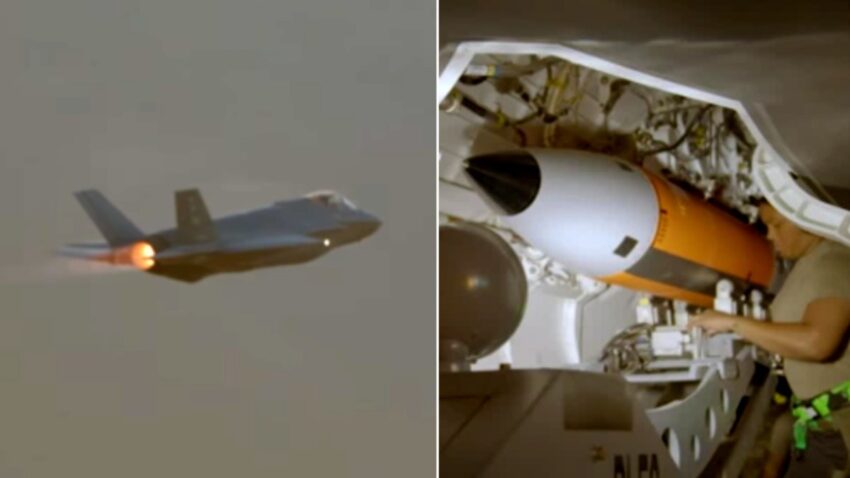**U.S. Successfully Tests Tactical Thermonuclear Gravity Bomb with Inert Warheads**
The United States successfully conducted tests of a tactical thermonuclear gravity bomb using inert warheads in August, according to the Department of Energy’s (DoE) National Nuclear Security Administration (NNSA), a key research and development arm. The exercise formed part of a stockpile reliability assessment, as stated in an official press release.
**Test Details and Execution**
Between August 19 and 21, the tests were carried out at the Tonopah Test Range in Nevada, with logistical support from Hill Air Force Base in Utah. The operation involved fifth-generation F-35A fighter jets carrying and releasing the bombs under operational conditions, marking significant progress in the modernization and reliability testing of the United States’ nuclear arsenal.
**Why It Matters**
This announcement comes just weeks after former President Donald Trump suggested that the U.S. might resume nuclear testing “on an equal basis” with other nations. The timing underscores Washington’s effort to reassure allies and demonstrate readiness amid rising global tensions.
Importantly, these recent tests highlight the U.S. commitment to maintaining a safe, reliable nuclear deterrent while respecting the decades-long ban on explosive nuclear testing.
**About the B61-12 Bomb**
The B61-12 is a modernized iteration of a Cold War-era nuclear bomb, designed to remain in service for at least 20 more years following a life-extension program finalized by the NNSA in late 2024.
According to Sandia National Laboratories—which manages the testing and is operated by National Technology and Engineering Solutions of Sandia, a Honeywell International subsidiary—these recent trials marked a “significant milestone in evaluating the weapon’s performance.”
Sandia officials noted that this testing series included the most comprehensive B61-12 flight testing conducted in a single year. It also featured a pioneering thermal preconditioning of the bomb prior to carriage on the F-35, steps intended to ensure the weapon meets environmental and operational requirements under real-world conditions.
The effort involved close coordination among Sandia, the NNSA, the U.S. Air Force, and multiple federal agencies.
**Sandia National Laboratories’ Role**
Operating under the DoE, Sandia works in tandem with the NNSA, the agency responsible for maintaining the U.S. nuclear stockpile. Sandia’s role focuses on designing and integrating the non-nuclear components of nuclear weapons to ensure safe and reliable functioning.
As the systems integrator, Sandia coordinates with other laboratories and contractors to certify complete weapon systems. This partnership is central to U.S. nuclear modernization programs, including the B61-12 Life Extension Program, which extends the service life of aging bombs without the need for explosive nuclear testing.
**Strategic Importance**
The B61-12 program plays a crucial role in modernizing America’s aging nuclear arsenal. It ensures compatibility with advanced aircraft like the F-35 while reducing reliance on high-yield weapons, a critical factor in both strategic stability and arms control discussions.
This bomb variant is compatible with various U.S. delivery platforms, enhancing flexibility and deterrence capability.
**Historical Context of Testing**
Flight tests of inert nuclear bombs are conducted periodically as part of routine certification and modernization efforts. For example, a similar exercise involving an Air Force F-16 fighter jet took place in 2017 under the auspices of the Air Force Materiel Command.
**Voices from the Field**
Jeffrey Boyd, surveillance lead for the B61-12 and B61-13 programs at Sandia, said:
> “These B61-12 F-35A stockpile flight tests and captive carry flight test were the capstone accomplishment of a tremendous amount of planning and effort by those involved—not only at Sandia but across many other agencies.”
He added,
> “These tests represent the completion of the most B61-12 flight testing surveillance ever conducted in a single year and the most in any year for the foreseeable future.”
Additionally, Tonopah Test Range manager Brian Adkins commented:
> “Expedient coordination by the entire test team resulted in two successful days of testing to evaluate three test assets.”
However, concerns about nuclear testing have been raised. Daryl Kimball, executive director of the Arms Control Association, told Newsweek in October:
> “It’s not militarily, technically, or politically necessary. It would lead to a chain reaction of nuclear tests by other countries, including Russia, probably North Korea, maybe China, and it would undermine U.S. security.”
**What’s Next?**
Officials state that the August tests represent the most comprehensive B61-12 flight evaluations in a single year and are likely the last of such scale for the foreseeable future.
Data collected will inform annual stockpile assessments and help maintain U.S. nuclear deterrence without resorting to explosive testing—continuing to respect international norms.
These developments come amid a sensitive geopolitical climate, with former President Trump’s remarks signaling a possible end to the longstanding U.S. moratorium on live nuclear testing.
Russian officials have warned of reciprocal measures if the U.S. resumes such tests. Furthermore, an upcoming unarmed test of a Minuteman III intercontinental ballistic missile, scheduled following Trump’s remarks, has drawn international scrutiny and may provoke strategic responses from Russia or China.
Energy Secretary Chris Wright emphasized that ongoing tests will not include nuclear detonations but will validate new subsystems and ensure overall readiness.
While the prospect of renewed nuclear testing remains uncertain, the current administration insists that any future tests will respect the global norm against nuclear detonations.
—
*This article reflects recent developments in U.S. nuclear weapons testing and modernization as of August 2024.*
https://www.newsweek.com/us-tests-b61-12-nuclear-bomb-11053024
